
Theory
of Human Experience
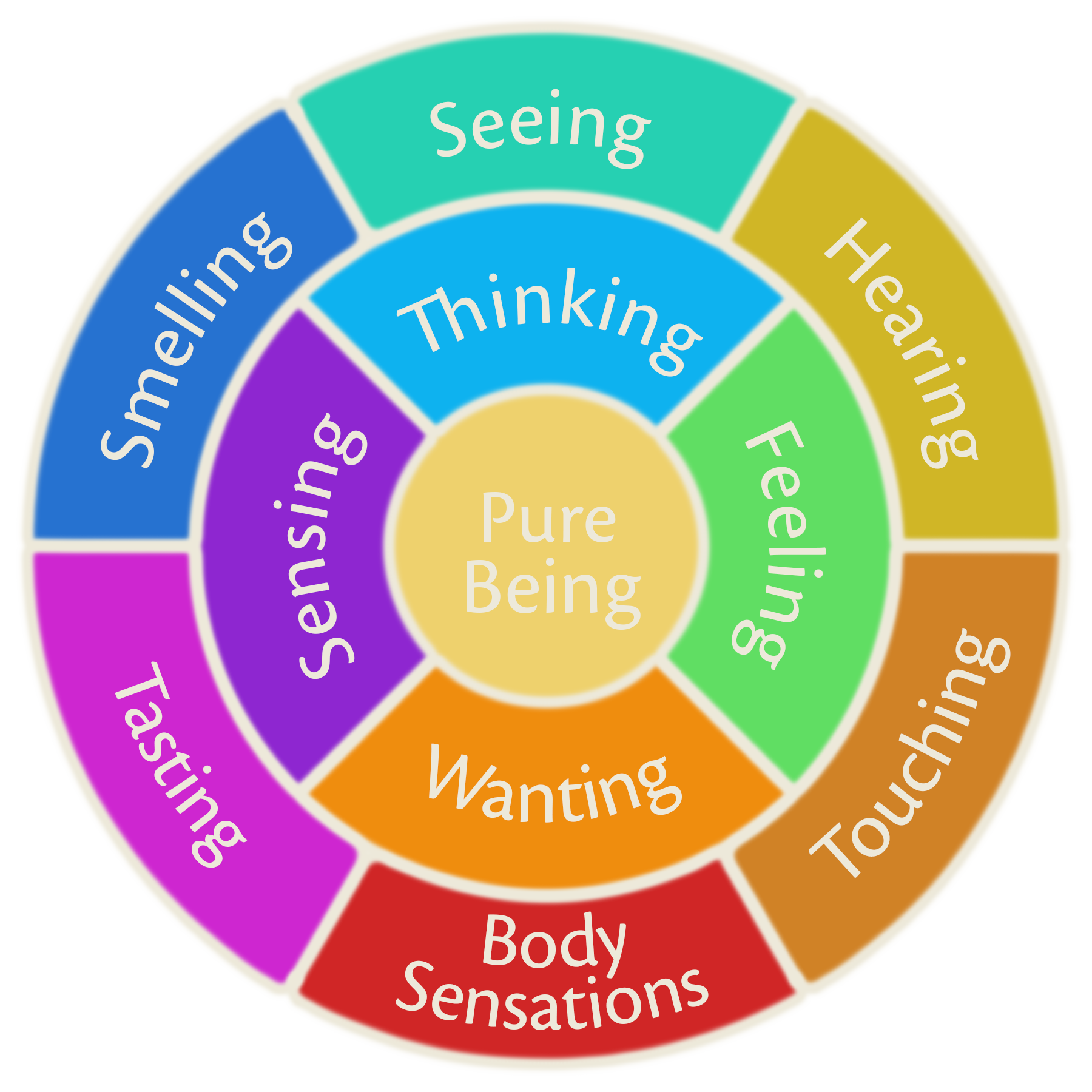
The eleven streams (areas) of human experience
Published by Christoph Steinbach on July 6, 2014 in Überlingen, Germany
A detailed description
Click on the headings:

Stream 1
+ Body sensation
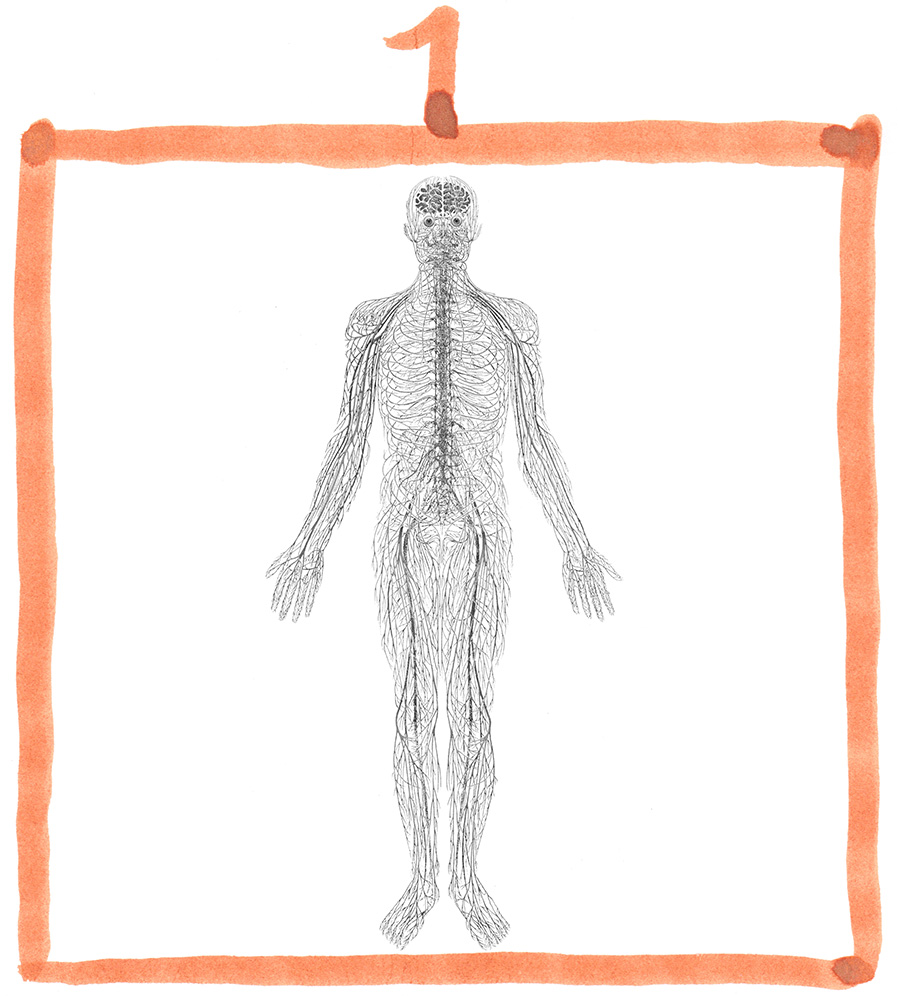
If you like: Pause, stand or sit comfortably, breathe in and out deeply and focus your attention on the interior of your body.
What expressions is your body showing at this moment? At which place exactly is your body showing you expressions at this moment?
Take your time in noticing your physical expressions, in listening to the language of your body, without allowing yourself to be drawn into your thinking and thus into judgment.
The language of the body is: here a pulling, there a pressing, a friction, heat, tension, a pain, tingling, rumbling, tingling and also a pleasant pulsation.
Breathe in and out deeply and perceive these impressions within yourself without judging them.
The body is the gateway to our soul. Nothing is more effective for stepping out of the spaces of thought and into a conscious and complete experience than to start listening to the language of your body.
Body sensation is the perception of the impressions of the inner body nerves.
At almost every moment the body communicates itself in fine and sometimes gross expressions.
Body sensation can be experienced at any moment as soon as you manage to step into the space of your body.
Every living thing on earth has physical sensations. An algae and a tree also have internal “nerves”.
© drawing: «Sacred Mirrors – The visionary art of Alex Grey», Publishing house Two Thousand Ones 1996

Stream 2
+ Touching
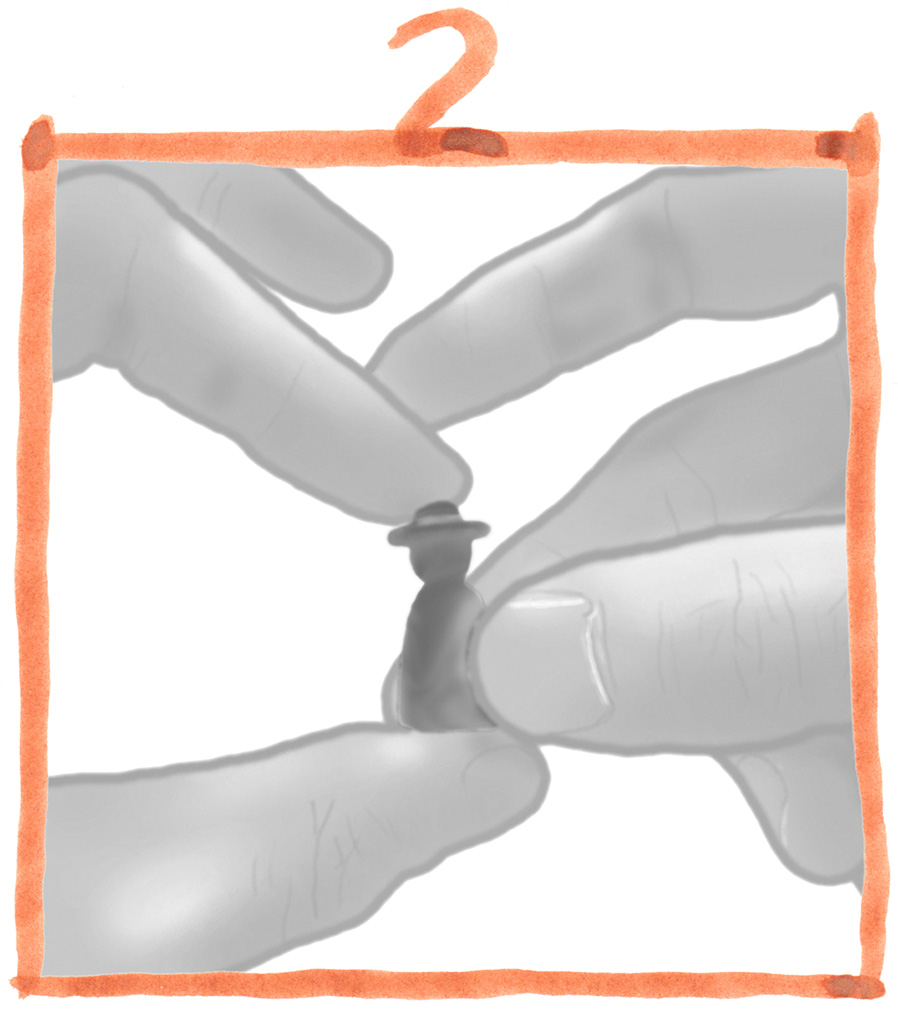
The entire surface of our skin is a sensory organ with which we register contact with adjacent bodies and also with moving molecules.
If you like: Close your eyes once and consciously feel an object in your fingers. Now you notice the nature of its surface, its weight, its contour and also its temperature.
Can we feel moisture with our skin?
If you can devote yourself entirely to touching, you may find that your mind becomes a silent observer of this experience.
Touching is the act of registering impressions with your skin.
Touching is present in every moment. It is not possible to turn off your own sense of touch. But we may have fallen into thought and loose the impressions of our skin in our consciousness.

Stream 3
+ Tasting
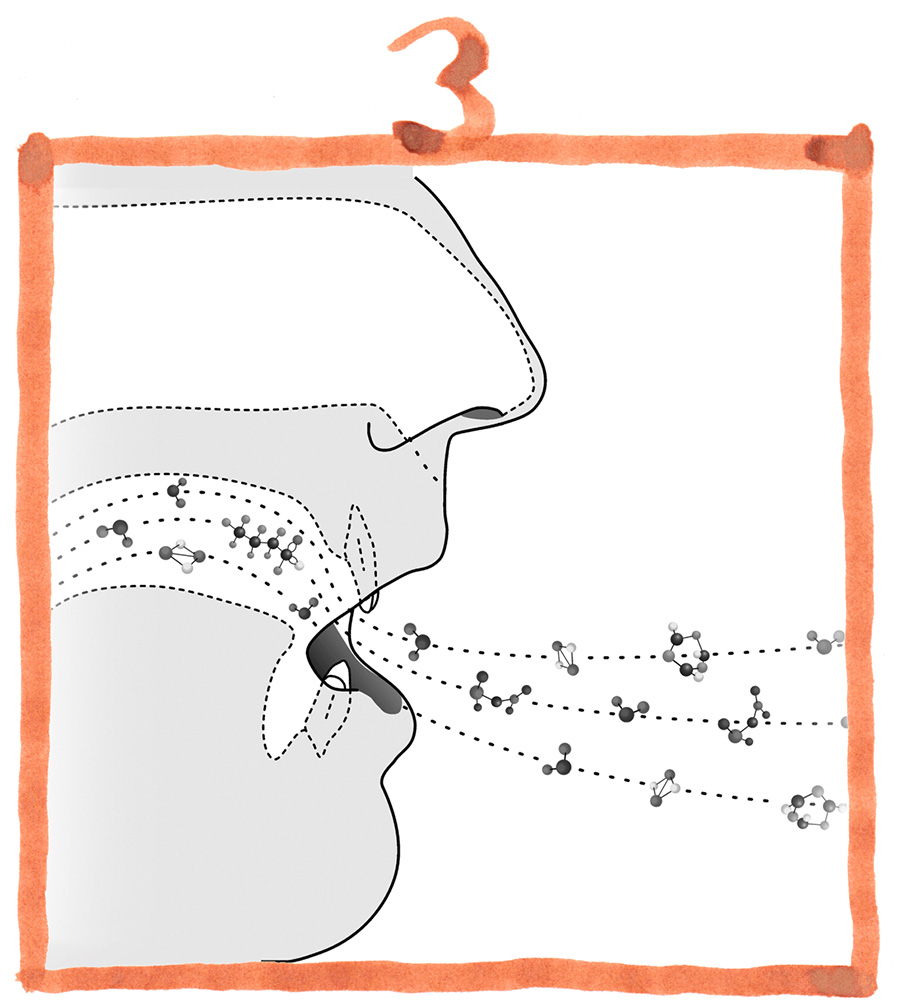
Almost everything we put in our mouths contains taste molecules. We register different taste impressions with our tongue and the skin inside our mouth.
Basic tastes are: sweet, sour, bitter, salty, tart, spicy.
If you like: Next time you eat, consciously put a piece of your plate in your mouth and taste it to discover which of the six flavors are contained in this bite.
The ‘taste’ of food is usually the combination of smell and taste impressions. Can you taste water if you hold your nose?
Tasting is the act of registering the taste molecules that enter your mouth.
The perception of the temperature and contour of a food in our mouth is a touch and not a taste.

Stream 4
+ Smelling
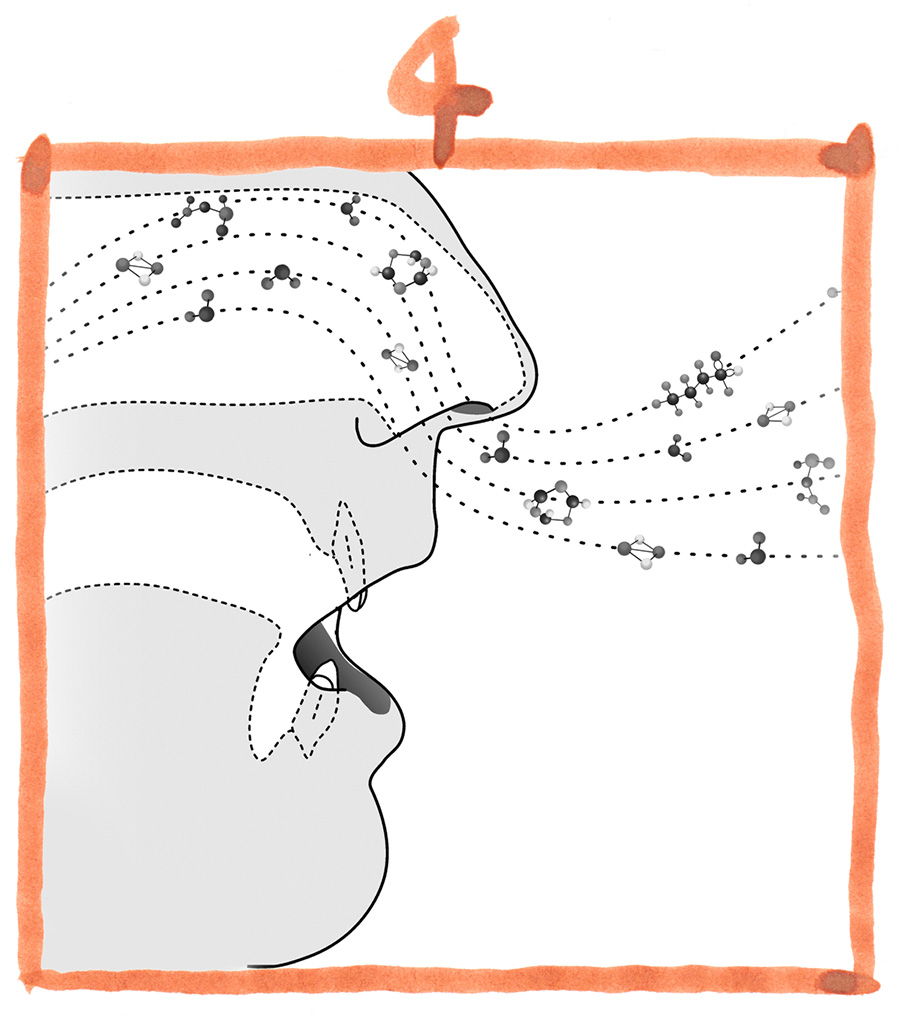
Almost every moment, the air that we breathe in through our nasal cavity contains odor molecules that our sense of smell registers.
If you like: Slowly and consciously draw the air up into your nasal cavity and past it.
Imagine if you had a much more refined sense of smell. You would definitely notice a variety of odor nuances in the air that you are currently breathing. In this imagination, can you get an idea about the many smells that are in the air around you?
If you devote yourself entirely to smelling, you may find that while you sniff your mind is silent.
Smelling is the registration of odor molecules that enter our nose.
The finer your own sense of smell, the more smelling can be experienced at almost every moment.

Stream 5
+ Hearing
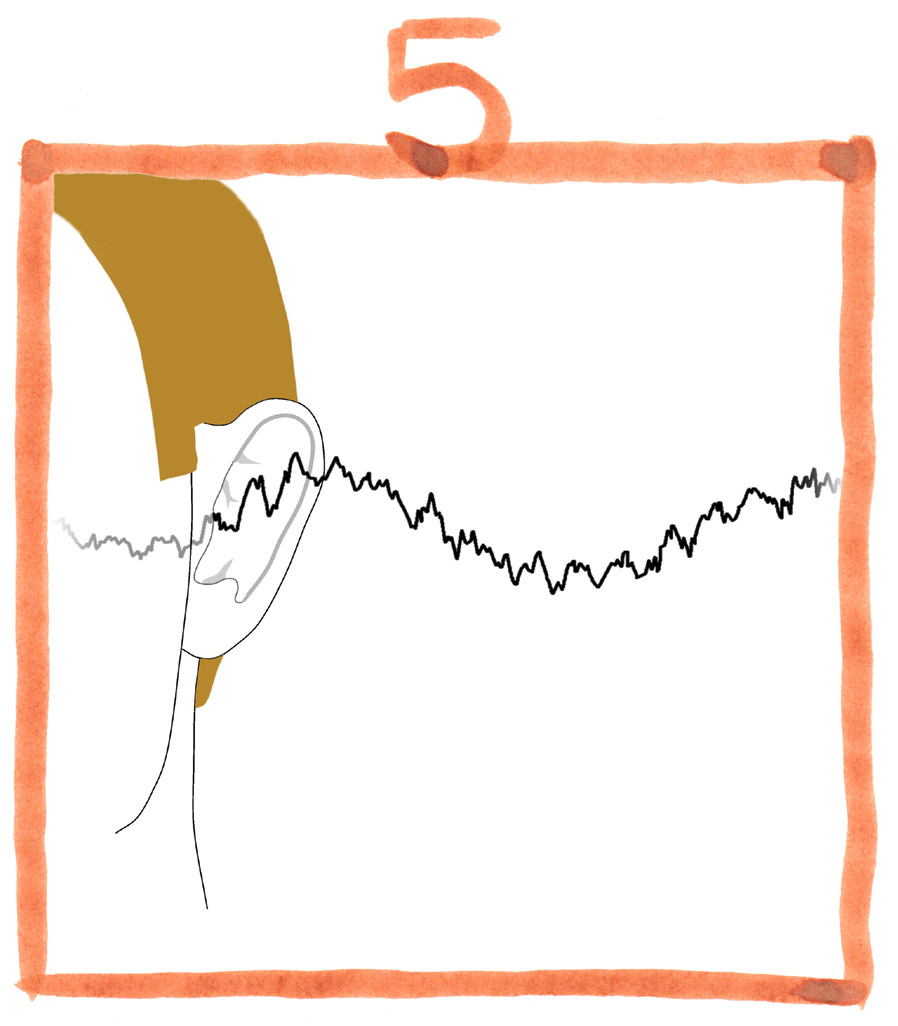
There is a difference between listening and devoting yourself to hearing.
If you like: Pause, breathe in and out deeply and become aware of the sound that is around you. Almost every moment we are surrounded by sound, by the vibrations that spread through the air from sound sources, passing through walls and filling the space around you. Consciously perceive the sound that surrounds you at this moment.
If you attend to all the sound at the same time and remain centered, you can notice how your mind stays in silence with you, listening.
Hearing is the perception of sound entering your ears.
With an intact sense of hearing, hearing can be experienced at almost any moment.

Stream 6
+ Seeing
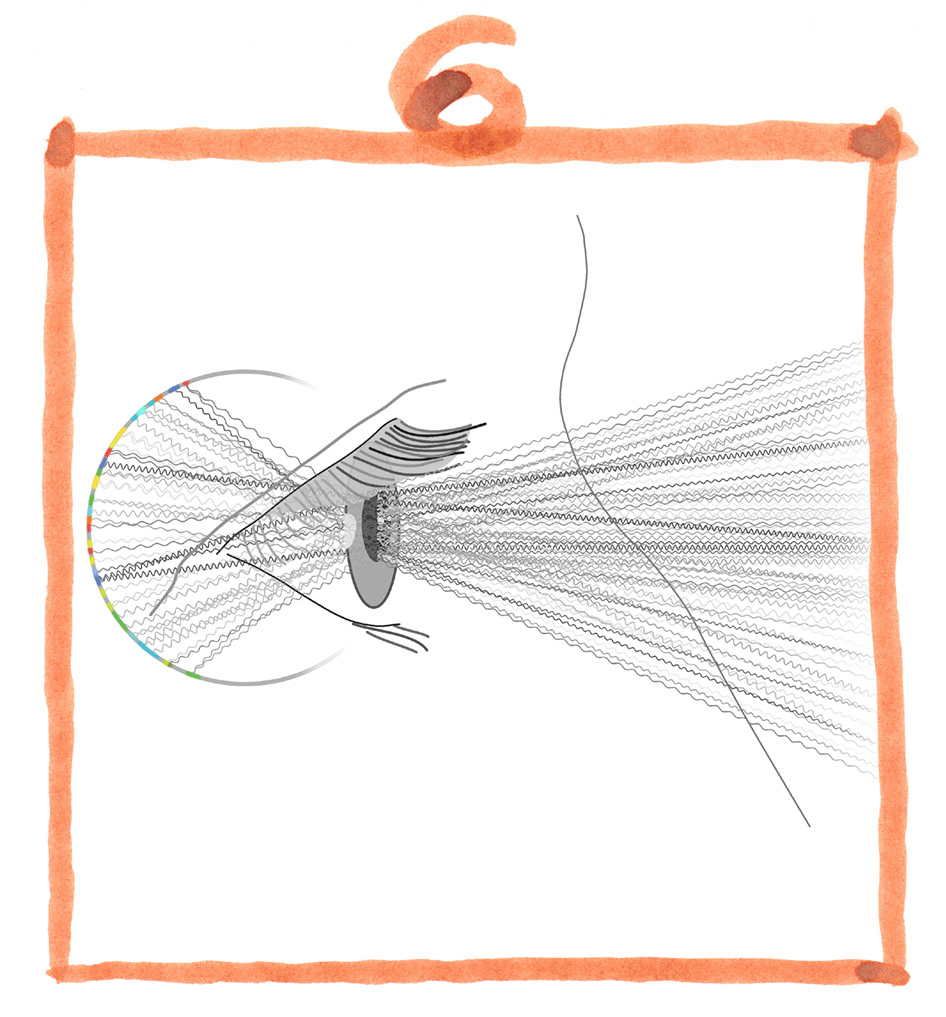
There is a difference between seeing and devoting yourself to seeing.
If you like: Pause for a moment, breathe in and out deeply, let your gaze widen and become aware of the light that is around you. It comes from the sun or light sources around you. The light reflects off the objects around you and enters your eyes.
See the light itself that enters your eyes. Dedicate yourself entirely to conscious seeing. If you succeed, you will notice how your mind remains reverently in silence.
Seeing, physical seeing with our physical eyes, is the perception of the light entering our eyes in all its ever-changing embossings.
With an intact sense of vision, seeing can be experienced at almost any moment.

+ Intermediate step
If you like: Stop for a moment, straighten up internally, breathe in and out deeply and consciously perceive the impressions of your sight, hearing, smell, taste, touch and body sensations at the same time.
This can usually only be achieved from one's own center and from the silence of thought. As soon as we withdraw from the expanded perception back into the spaces of our thinking, our attention is directed again to individual details within the wide range of sensory impressions; Thinking describes and judges and the many other simultaneous sensory impressions recede into the unconscious perception.
Practice allowing all sensory and physical impressions to flow into you in conscious serenity in order to enjoy this awareness, this inner silence and presence.

Stream 7
+ Thinking
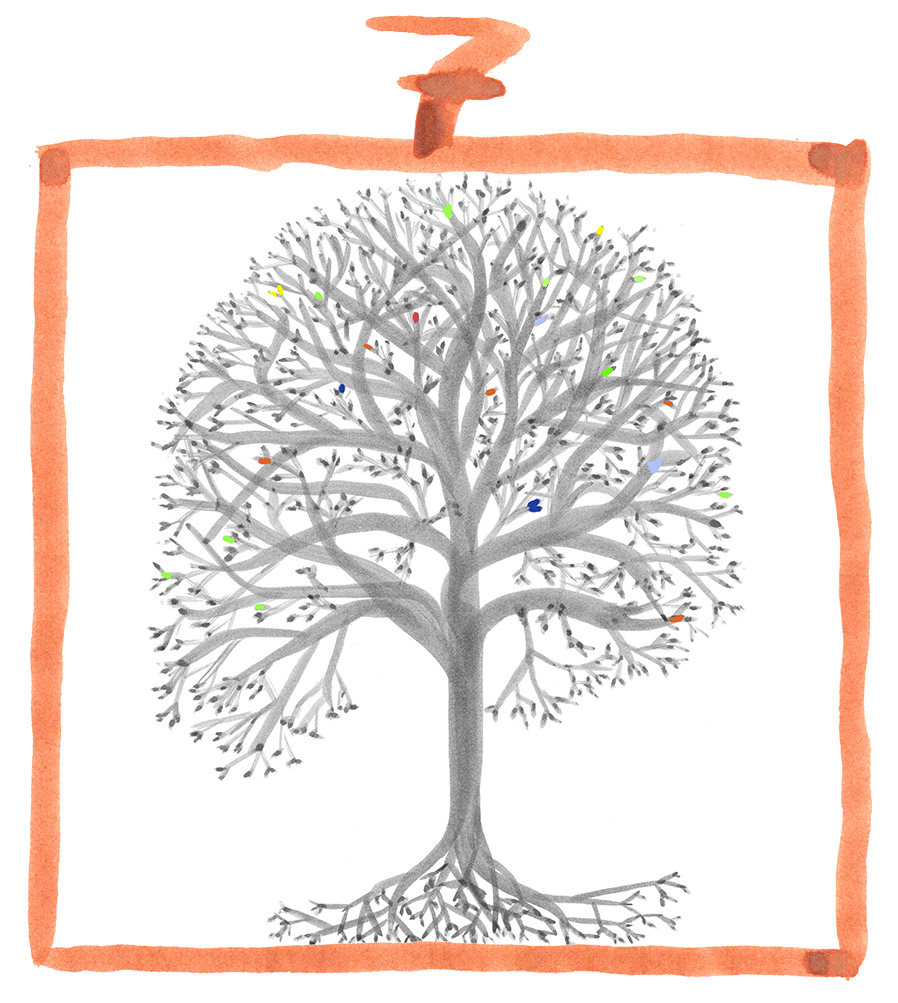
If you like: Pause for a moment, straighten up internally, breathe in and out deeply and focus your attention on the space behind your eyes, on the place of your thinking.
If you want, count slowly from one to eight in your mind and then stop counting. You may now have heard your thoughts within yourself. They are mostly words and sentences in a ‘toneless’ voice. Sometimes thoughts also take the form of inner images and moving scenes.
It is possible to consciously hear and see the thoughts within yourself and also to experience moments when the thoughts are silent.
Thinking is hearing and seeing words, sentences and images and, in deeper thinking, also perceiving other sensory impressions in the space of our mind.
Thinking is sometimes an inner conversation, sometimes with ourselves, sometimes with someone we know.
Thinking can be experienced consciously at every moment as soon as we manage to step out of the room of thoughts. The thoughts within us are only audible and visible when we are ‘in our inner center». From this place we can friendly view our thoughts.
Thoughts have different qualities: there are recurring worries, circulating thoughts, ideas, fantasies, inspiration and insights.
The more we manage to consciously feel, sense and feel our bodies, the better we can distinguish the quality and origin of the thoughts within us.
We people in the Western world are currently flooded with impressive sensory impressions. Our minds are often overwhelmed by processing these impressions, so we can hardly bear to consciously see and hear the stream of thoughts within us.
PS: In the illustration, the tree symbolizes our mental structure that has grown over the course of life: our personal that's-how-it-is-network in which one thought has grown into the next.

Stream 8
+ Feeling
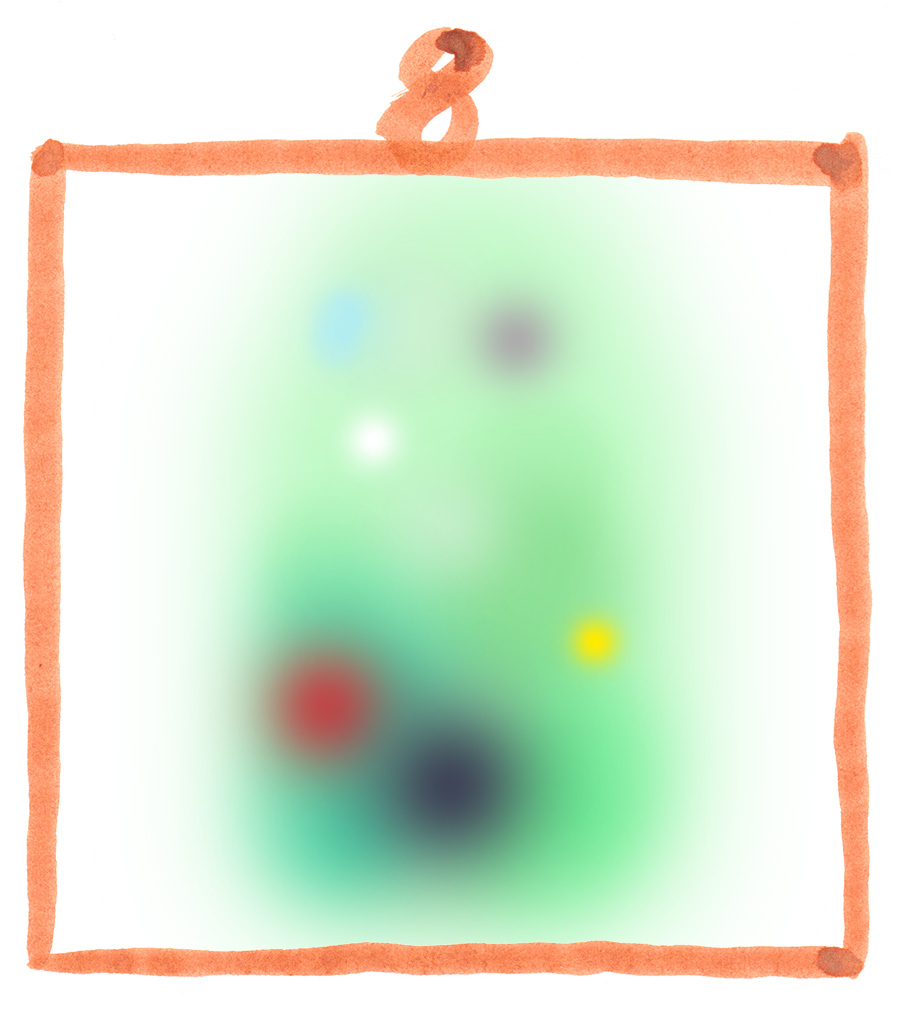
If you like: Pause, breathe in and out deeply and feel your mood.
Feeling is like smelling, tasting and touching: at every moment there is a feeling within us, a mixture of basic feelings in ever-changing compositions. We don't always notice it consciously.
Feeling is the ever-changing mixture of the six basic feelings in ever-changing weighting: fear, fury, joy, suffer (the deep mood), sadness and love. There is only one feeling within us at any given moment, this can be understood as a «coloring» of one's own vulnerable soul.
Your own mood is the proportion of joy and suffer in the current mix of feeling. In a ‘high mood’ there is a high proportion of joy in the mixture of feeling and in the ‘medium mood’, joy and suffer are balanced. In the ‘deep mood’ joy is no longer present in the mixture and there is a high proportion of suffer. Your own mood moves lively up and down between these poles.
Emotion is the ‘moving out’ of one's own feelings in the form of words, gestures and actions (‘movere’, Latin = to move). Your own fury, for example, can be experienced in inner peace and inner strength without directing it at someone, something or yourself.
Feeling is the ever-changing coloring of one's own soul (mind), which does not require words or images.
Our own momentary feeling is perceptible as soon as we devote ourselves to the coloring of our own mind.
There is not a single human on earth who is without feeling. However, there are many in the Western world who are rarely aware of their feelings or only notice the feelings when they are very intense.
Every feeling that arises from within us has a meaning and is a directive, a hint from our own Self.
Feeling and thinking stand side by side in us like siblings: each equally powerful and equally wise. We become complete again when we connect feeling, thinking and willing within ourselves in love.

+ The independence of the streams
The events in the streams, the sensory impressions, thoughts, feelings and physical sensations, seem to be independent of each other; no event in one stream certainly causes an event in another stream.
The events in seeing and thinking are independent: I look out of the window in front of me, as I have done so often, and often have different thoughts, even though the view is often very similar.
Die Geschehnisse im Körperempfinden und Denken sind eigenständig: Immer wieder einmal empfinde ich bewusst die Verspannung im Nacken und habe doch unterschiedliche Gedanken zugleich.
The events in body sensation and thinking are independent: Every now and then I consciously feel the tension in my neck and yet have different thoughts at the same time.
We have habits and patterns: Whenever I hear that particular song, I feel nostalgic. When I feel pain, my mood is usually low.
The feeling of pain and feeling the low mood are not firmly linked: those who feel more or less permanent mild pain still often have an elevated mood at the same time.

+ Pure feelings
Fear, anger, joy, low mood, sadness and love are pure feelings. Each of these inner colors can be felt in the silence of thought and therefore has no mental component.
Anger is also a pure emotion because it is the mixture of anger and deep mood. Happiness is a pure feeling because it is the mixture of joy and love. Courage is a pure feeling because it is the mixture of anger and love. I can feel courage within myself and my thinking is still at the same time.
Pure sadness can also be felt in a low, medium or high mood.
Other emotional expressions that we have given names are a mixture of thinking, feeling and sometimes physical sensation. Jealousy, for example, is a mixture of anger, low mood, and a mental construct of comparison and blame. Shame, for example, is a mixture of fear, low mood, and a mental construct of external danger and internal vulnerability. Lust, for example, is a mixture of joy, desire and bodily excitement.

+ Love
With the word ‹love› we name two things at the same time: On the one hand, love is a feeling, probably the most longing and fulfilling expression of our feelings. On the other hand, love is a magical bond that connects two people in particular. This connection often lasts for a very long time and survives all possible events in the currents of experience of the two connected people.

Stream 9
+ Sensing

As a human on earth we are physical beings, spirit and Self at the same time at every moment. As physical beings, we have the five physical senses: sight, hearing, smell, taste and touch. At the same time we perceive the impressions of the inner body nerves, we have bodily sensations (see stream 1).
As spirits, we have additional senses, the so-called ‘higher senses’. The word for this is ‘to sense’.
Sensing is not feeling or physical sensation. It is a collective expression for the higher senses. The proximity of the word to the word ‘senses’ shows that these are sensory perceptions.
The more practiced you become at sensing, the more you notice that other sensing people around you have almost the same impressions.
Sensing people perceives the current narrowness or width of their own energetic being, the width of the opening of your own heart, the density or lightness of the space arround you, a multitude of energetic impressions from the space of your own body, the true mood of a fellow human being, the current emotional expression of a fellow human being, the strength of the will that he or she directs towards you, the narrowness or breadth of a fellow human being's energetic field, the openness of a fellow human being's heart, the truthfulness of what he or she says, unspoken intentions behind what is spoken, the psychological injury of a fellow human being, the quality of objects, energetic fields and phenomena in nature, places of power, energy transfers between people, soul-like presences, large collective events, even if they take place in the far distance, and much more, depending on the subtlety and openness of your higher senses.
Sensing is the perception of the impressions of the higher senses.
Feeling can be experienced by stepping out of the spaces of thought and devoting yourself to the impressions of the subtle senses.
If you like: exchange ideas with sensitive fellow human beings in this sensing practice in order to check what you are truly experiencing and what is just an illusion of thought.

Stream 10
+ Wanting and not wanting
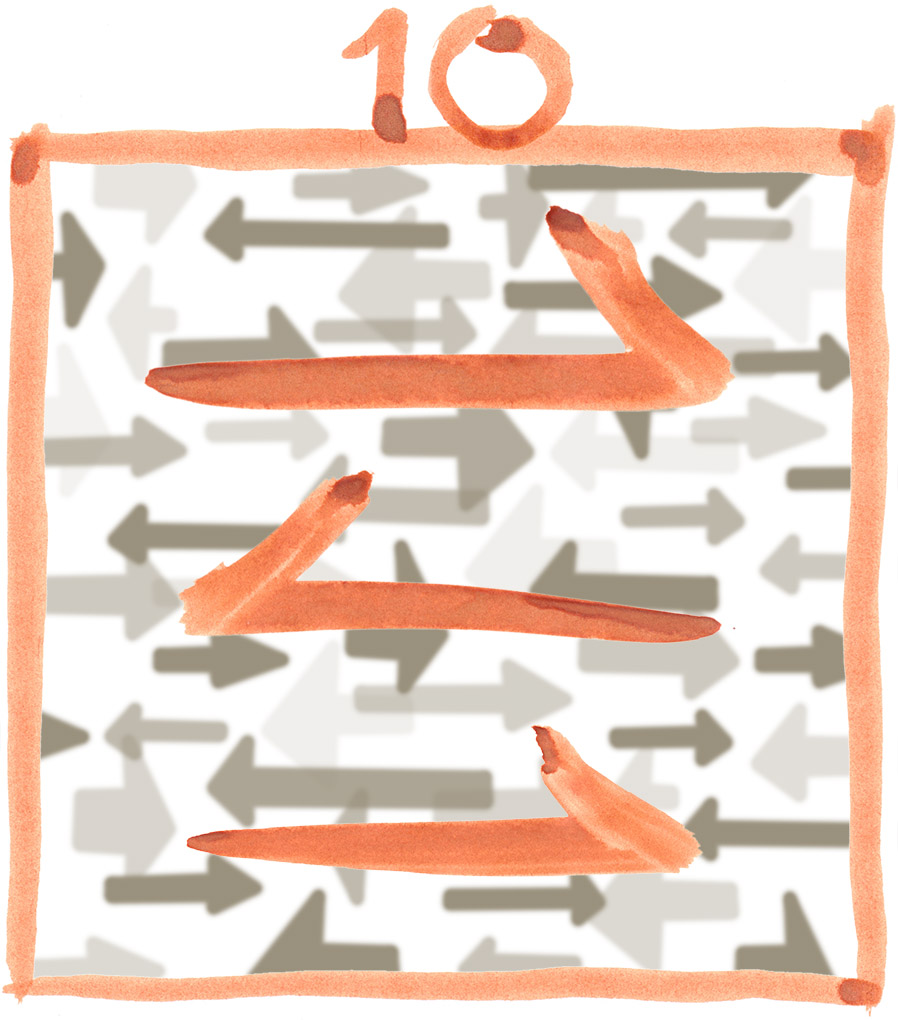
If you like: Stop for a moment and search within yourself: Is there a wanting in you at this moment?
Have you ever consciously experienced moments in which you were without desire, “all life flowed by itself” and you were completely dissolved into the ONE LIFE?
If you want: Take a deep breath in and out. Even in ‘dissolved moments’ the breath rises and falls in the chest, the heart beats and the eyelids blink over the eyeballs again and again.
This tenth stream of experience is the most mysterious of our experiences so far: the human will.
Who is doing everything that is happening at this moment? Is ‘it’ happening? How much of “what happens” do you do yourself?
The countless fine and gross body movements, the movements of the psyche, of the mind, the feelings that 'emerge', the thoughts, the words that are formed by our throat and enter the world through our mouth. The ones that don't leave our mouths because something or someone in us doesn't want to say it.
When considering the ability to experience one's own will, wanting and not wanting, the events in this stream are divided into three interlocking parts: (1) Wanting as holding on to a thought, (2) Wanting as movements of the body out of itself and: (3) Wanting as an overall event in life that “takes a person by the hand” over a long period of time and makes many things ‘happen’. and leads him or her to something (coincidence, fate, common steps).
The will is the creative power of man. A person without will parts 1, 2 and 3 would be completely lethargic in body, psyche and spirit, would not ‘do’ anything internally or externally and would therefore not create anything. Unless an alien will was master of body, mind and soul and would take over everything the human being did and moved that had degenerated into a robot.
A willing person can shape his own life to a large extent and also influences those around him.
Some speaking and thinking are ‘empty words’ if they are not filled with true wanting.
Not wanting can be found primarily in thinking. It is also a movement, moving the hands and upper body back, stepping back the feet and legs, turning the whole body away. A small child obviously does this, even without thinking (?).
If you like: Step back every now and then and experience the flow of your life in all its aspects, internally, bodily and externally.
Wer ist es, der dein Leben fließt?
Written at june 18, 2022

Stream 11
+ Pure Being
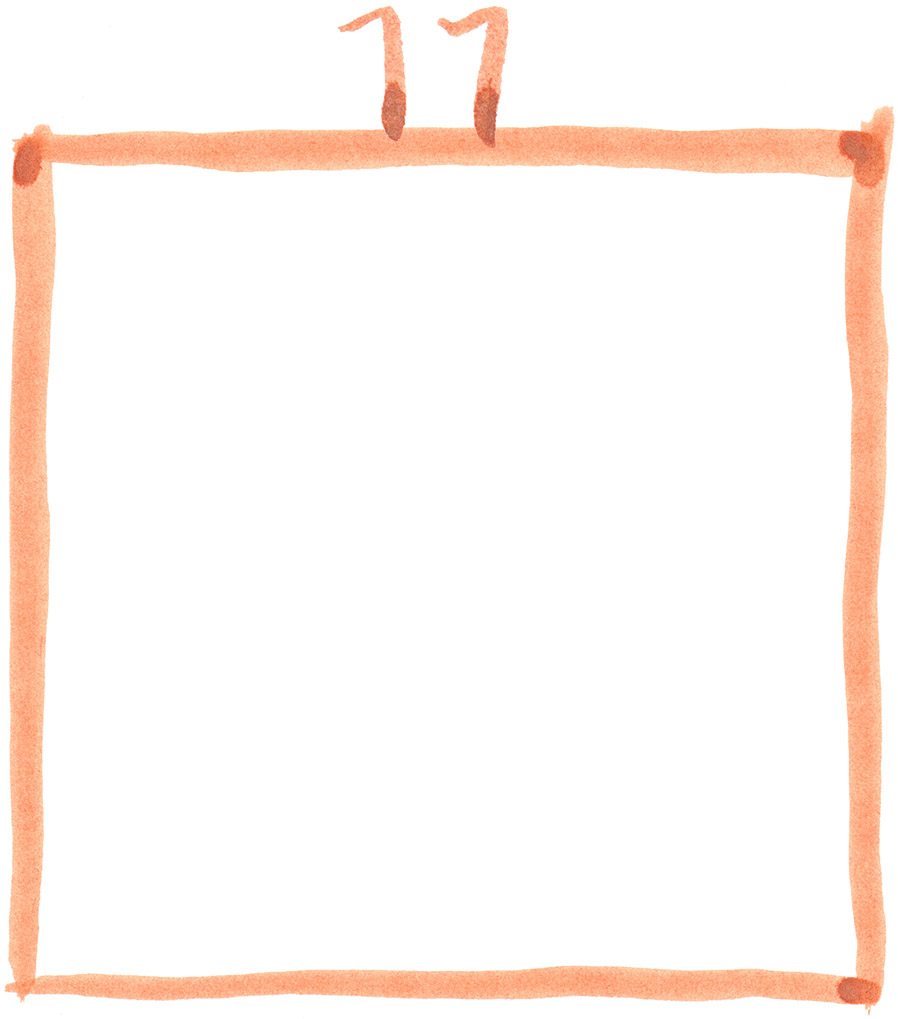
If you like: Look again at the illustration of human experience with its eleven areas.
If you have clarified yourself to the point where you truly experience each of the first ten areas within yourself, without being subject to any illusion, then you may succeed in the following exercise:
Retreat to a protected place where as few sensory impressions as possible reach you. Sit comfortably with your spine straight. Breathe in and out deeply and straighten up internally.
Now close your eyes and gradually go through the first ten areas of human experience. Perceive each area with its impressions and calmly move further inside into the expansion of your being into the One Unchangeable.
When you truly find this inner expanse, this inner space, in which no impressions of the first ten areas still capture you, you experience the deepest possible human experience. Because we humans always experience, in every moment. Experience never ends.
When you reach the inner space of your Self, you experience Pure Being, infinitely vast, full of purity and peace, loving and unchanging in time.
Pure Being is the experience of the Self within us, which is closely interwoven with our own liveliness, which animates all life.
Pure Being can be experienced by all those who manage to awaken and consciously accept everything they experience in the first ten areas without being surrounded by any single impression.

+ The place of attention
In addition to the eleven areas of human experience mentioned so far (seeing, hearing, smelling, tasting, touching, physical sensation, feeling, thinking, sensing, wanting and Pure Being), there are two more things that can be experienced, that are not a “stream of experience“ but rather the experiencer himself:
Our attention, the focus of our experience, the place of our experience, is sometimes concentrated in a certain place in space, sometimes concentrated in the space of our own body, sometimes in the space of thinking and sometimes extended far from our own center (space of the heart, inner awareness). The place and the breadth of one's own attention can be experienced.
If you like: Stand on the side of a busy street and notice how your attention jumps from person to person and object to object. Practice bringing your attention back to yourself, even in the middle of busy events.
Maybe you will be able to reach so far into your inner presence, even in the midst of all kinds of sensory impressions, that you can let your attention expand from within yourself. Now you perceive all the impressions within you and around you without jumping from one event to the next.

+ Your own consciousness
Each and every one of us has our own consciousness. It is the vastness of one's own perception that changes from moment to moment.
When going for a walk, some people notice the sights around them, hear the rustling of the trees and the chirping of the birds, smell the scent of the fir trees, feel the ground through the soles of their shoes, feel their own emotions, feel their own body and feel it.
Another person is so absorbed in thought at the same time and place that he is not consciously aware of the impressions of the other areas of his own experience.
Anyone who practices conscious experience will succeed in experiencing the own consciousness. It is possible to perceive within oneself how far one's consciousness extends beyond the areas of one's own experience. It is possible to consciously experience in other moments how much one's own attention is concentrated on individual events (especially in thinking).
Consciousness is the breadth or narrowness of one's own current perception.
The narrowing and widening of one's own consciousness has a loving reason: it is not always healing and helpful to consciously perceive the many impressions externally, physically and internally at the same time.

+ Doing
If you want: Ask yourself at the end of the day: “What did I do today?” “What has moved through me in my world?”
All life seems to consist of doing and being, see above. Experiencing seems to be more on the side of being, because in purely perceiving seeing, hearing, smelling, tasting, physical sensation, feeling and sensing we apparently do nothing.
Someone sitting in the garden by the pond, watching the frogs and listening to the sound of the wind in the trees, is – if you look from the outside – not doing anything. Someone who mows the lawn, trims the hedge, pulls weeds in the garden can rightly claim in the evening that he or she has done something today.
Doing seems to be three things: separating, connecting, moving. Ramana Maharshi once said: “A meditator is like a running fan. A viewer may say, ‘You're not doing anything,’ but the blades of the fan are rotating so quickly that the movement cannot be seen with the physical eyes.”
Our life seems to encompass at least two levels: the physical, ‘outer’ world and the subtle, spiritual, inner world. Even if we don't move or change anything on the outside, we can move, separate and connect a lot in our minds, which can be sensed and experienced by others.
Our existence never seems to begin or end. We are ceaseless. It's hard to tell that our being is sometimes more and sometimes less.
Our doing seems, viewed from the outside - especially from the perspective of some superiors – very likely to be sometimes more and sometimes less.
The basis of action is movement. Without movement of the body and mind, no action can be experienced. The experience of one's own actions can be determined by one's own movement. It is hardly possible for a person not to move at all in one moment, neither in body nor in mind. In most cases, the movement in the mind increases as the movement of the body decreases. The state can certainly be experienced in which the body sits at rest and the mind is open and purely perceiving. Can the person meditating in this way justifiably claim: “I do nothing”?
We humans can shape our own world and influence those around us, see also stream 10: ‘Wanting and not wanting’. A yoga teacher who also gives massages moves and connects a lot. Seen from the outside, he or she is not doing any separation. However, his mind may judge ‘good’ and ‘bad’ on a daily basis. Every day, a craftswoman saws boards, tears down old walls and takes the rubble to the dump. There are many things that she separates, but perhaps her spirit is a constant flow without judging in this activity.
We can do and create a lot with our hands and mind. Our experience is also shaped by our own actions: bodily sensations change through standing up and moving, touch changes through contact, tasting through the introduction of food, smelling through thoughtful sniffing, hearing through listening, seeing through widening the gaze and turning the head, thinking by thinking over, devising, composing and finding solutions, feeling by raising or lowering our mood, by turning towards ourselves or close fellow human beings, sensing by moving to places and directing one's own attention, willing by directing one's own attention.
Seen in this way, not only our being is continuous, but also our actions. At some moments we seem to be more occupied with the external world and at other moments more occupied with the internal world. Some people manage to connect both worlds and penetrate these levels like the Chinese character for ‘king’ (three horizontal lines on top of each other, with a vertical line running through them in the middle).
If you want to expand your awareness of your actions, ask yourself: “What have I separated today, what have I connected today, what have I moved and changed today?”
Written on July 30, 2022

+ Reverse conclusion
Here is a check for the completeness of the description of human experience:
«What else would we experience if our vision were black and without impressions, if our hearing were silent, if we didn't smell or taste anything, if our skin didn't perceive any tactile impressions, if our bodies didn't show any physical sensations, if we didn't feel anything , wouldn't sense anything, wouldn't want anything and our thinking would be silent and empty and we would have neither words nor images in our minds?»
We would experience the eternal and imperishable Pure Being that is unified for every being.

This description is an invitation to take a look inside yourself and compare what has been said with your own perception.

Imprint
The description of the human experience is part of the jahnna project, which has been publishing exercises, consciousness and visions of humanity since 2003. All content is a free gift for all loving and open-hearted people.
More about the jahnna project at: www.jahnna.ch (in german language)
More about the Psychology of Experience: www.erlebbare-psychologie.ch (in german too)
A visit to the author of this page: www.luetzelhuus.ch -› Über uns
This page published on February 22th, 2024





